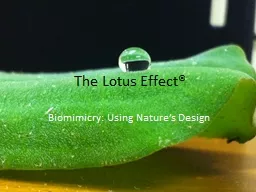

What is the Lotus Effect The Lotus Effect refers to the remarkable ability of the lotus plant to repel dirt and water This ability known as superhydrophobicity or extremely water repellence can be found in many different species ID: 711800
Download Presentation The PPT/PDF document "The Lotus Effect® Biomimicry: Using Nat..." is the property of its rightful owner. Permission is granted to download and print the materials on this web site for personal, non-commercial use only, and to display it on your personal computer provided you do not modify the materials and that you retain all copyright notices contained in the materials. By downloading content from our website, you accept the terms of this agreement.
Slide1
The Lotus Effect®
Biomimicry: Using Nature’s DesignSlide2
What is the Lotus Effect®?
The Lotus Effect refers to the remarkable ability of the lotus plant to repel dirt and water.
This ability, known as
superhydrophobicity
or extremely water repellence, can be found in many different species.Slide3
The Lotus Effect in Nature
Why would a species need to be superhydrophobic? How could this benefit them?
Make a list of species that you predict might need to be extremely water repellent. Slide4
The Lotus Effect in Nature
Water striders are
one example of an organism that
displays
Superhydrophobic
qualities.
Image Credit:
Retrieved from:
University of Liverpool Research Intelligence: Surface TensionSlide5
Why the Lotus Effect?
If there are so many creatures out there exhibiting this characteristic, then why is it called the Lotus Effect?
That’s because the lotus plant seems to be superior in repelling water and “self-cleaning”.Slide6
The Lotus Plant
Image Credit:
Retrieved from:
University of Liverpool Research Intelligence: Surface Tension
W
ater beads up on the lotus leaf rather than spreading out and sticking to it.
This is a characteristic of the “lotus effect”.
Notice how smooth the surface of the leaf is. Slide7
Water Lettuce
Another plant, called water lettuce, displays the lotus effect as well.
Water lettuce, like the lotus, is a pond plant. However, unlike the lotus leaf, the water lettuce is covered in tiny hairs.
It also repels water, causing it to bead up and fall off. Slide8
Why do they do this?
For years this question went unanswered and was left as a phenomenon of nature.
With modern technology we now know a little more.
The surface of the lotus plant appears smooth, but upon a deeper look you can see roughness and bumps on the nanoscale.Slide9
Why do they do this?
While the surface of the water lettuce does not appear smooth like the lotus, its nanostructure is similar with
nanosized
roughness and bumps found beneath the surface hairs.Slide10
Nanostructure of Water Lettuce
This image shows the rough surface of the lettuce leaf beneath the surface hairs.
A scanning electron microscope took this image and shows structures smaller than 100µm.Slide11
What’s surface roughness got to do with water repellence?
The roughness discovered on the nanoscale of these leaves gives us insight to why they are so good at repelling water.
The tiny bumps trap air between them, which in turn makes it impossible for water to actually touch the surface.Slide12
Water droplets end up
as beads sitting on top of
teeny, tiny air pockets.
Cool, huh? Slide13
Even when submerged under water the air pockets prevent water from adhering to the surface.
See how the surface looks silvery beneath the water? That’s from all of the air trapped beneath!Slide14
Nano-what?
So, the surface of these plants are rough on the nanoscale. What exactly does that mean?
A nanometer is a measurement of one billionth of a meter…that’s really small!
By being able to observe things, like these leaf surfaces, at such a high magnification, we can learn how nature creates such remarkable structures. Slide15
How can this help us?
By investigating the way that nature designs things we can improve the way that we design things.
Using nature to inspire new or improved products to help mankind is called “biomimicry”. Slide16
Biomimicry
Biomimicry has been around for a long time. You already read about Velcro and its inspiration coming from nature, but there many more examples out there.
Engineers today have amazing tools that allow them to really go beyond the surface of Mother Nature’s creations and see what they are really made of. Slide17
Biomimicry
By investigating organisms, like the water lettuce or lotus leaf, on the nanoscale engineers are able to recreate these surfaces on man made products.
How is this technology related to what you investigated in your laboratory activity? How about the video you watched involving the ketchup bottle? Slide18
Biomimicry
Some of the water repellent surfaces you observed in your lab as well as the ketchup bottle involve biomimicry inspired from the Lotus Effect.
What other ways could we use this technology to make our lives easier, safer, or better?